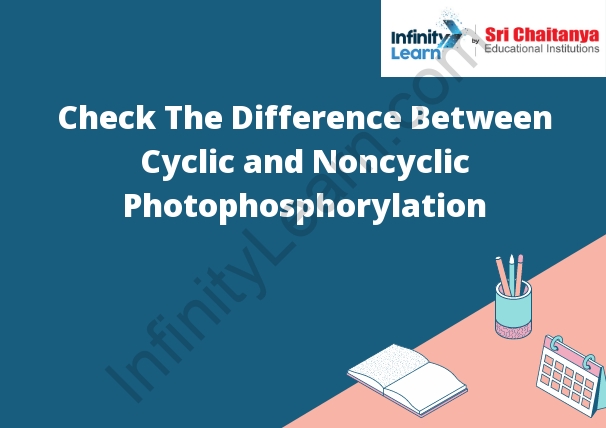Table of Contents
The Difference Between Cyclic and Non cyclic Photophosphorylation
Check The Difference Between Cyclic and Non cyclic Photophosphorylation:
Cyclic photophosphorylation is a type of photophosphorylation that occurs in photosystem I and photosystem II. In cyclic photophosphorylation, a photon is absorbed by a photosystem, and an electron is transferred from a light-harvesting complex to the reaction center. This electron is then used to reduce NADP+ to NADPH.
Noncyclic photophosphorylation is a type of photophosphorylation that occurs in photosystem I. In noncyclic photophosphorylation, a photon is absorbed by a photosystem, and an electron is transferred from a light-harvesting complex to the reaction center. This electron is then used to reduce water to oxygen and protons.

What is Photophosphorylation?
Photophosphorylation is the process that uses light energy to convert ADP and Pi into ATP. This process occurs in the thylakoid membrane of the chloroplast.
Photophosphorylation is of the Following Two Types
There are two types of photophosphorylation:
- Non-cyclic photophosphorylation
- Cyclic photophosphorylation
1. Non cyclic photophosphorylation
In non cyclic photophosphorylation, the electrons that are excited by light energy are transferred directly to an acceptor molecule, such as oxygen. This process produces ATP and water.
2. Cyclic photophosphorylation
In cyclic photophosphorylation, the excited electrons are transferred to an intermediate molecule, such as a quinone. This process produces ATP and NADPH.
What is Cyclic Photophosphorylation?
Cyclic photophosphorylation is the process that takes place in the thylakoid membrane of the chloroplast during photosynthesis. Light energy is converted into chemical energy in the form of ATP and NADPH. The light energy is converted by the light-dependent reactions, which take place in the thylakoid membrane. The ATP and NADPH are then used in the light-independent reactions, which take place in the stroma of the chloroplast.
What is Noncyclic Photophosphorylation?
Noncyclic photophosphorylation is the process by which light energy is converted into the chemical energy of ATP. This process occurs in the thylakoid membranes of chloroplasts and is initiated by the absorption of light by photosystem II.
Cyclic and Noncyclic Photophosphorylation Class 11
Cyclic photophosphorylation is a process in photosynthesis by which light energy is converted into chemical energy that can be used by plants to create glucose from carbon dioxide and water. The light energy is converted into an electrochemical gradient that is used to power ATP synthase to create ATP from adenosine diphosphate (ADP) and inorganic phosphate (P i ). Noncyclic photophosphorylation is a process in photosynthesis by which light energy is converted into chemical energy that can be used by plants to create glucose from carbon dioxide and water. The light energy is converted into an electrochemical gradient that is used to power ATP synthase to create ATP from adenosine triphosphate (ATP) and inorganic phosphate (P i ).
Significance of noncyclic photophosphorylation
Noncyclic photophosphorylation is the process by which light energy is converted into adenosine triphosphate (ATP) in photosynthesis. In this process, light energy is absorbed by photosystem II and used to create a high-energy electron. This electron is passed along a chain of electron carriers, eventually reducing NADP+ to NADPH. The energy from the electron is then used to create ATP from ADP and phosphate.









